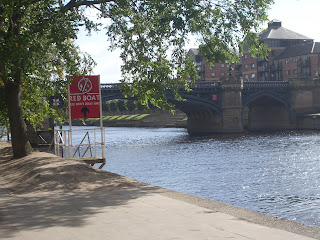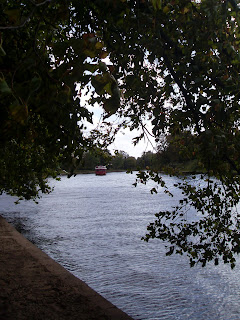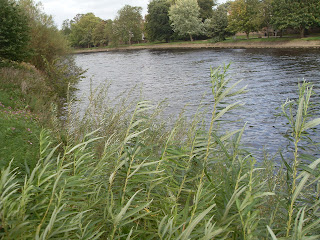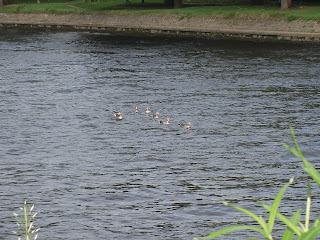If the strong Cane support thy walking Hand,
Chairmen no longer shall the Wall command
- Trivia, John Gay
In the beginning of the 18th century part of the public discourse of Britain was marked by a clash of estates over the use of the cityscape. While the members of the upper class desired to stroll the streets, the working class used the exact same space to conduct their business. In essence this was a debate with the mercantile interests on the one hand and the rising leisure culture of the gentry on the other, a struggle between producers and consumers, both of which were acknowledged as important parts of the proto-industrialist world of Britain.

The leisure culture of the early 18th century was made manifest in various ways. The book trade blossomed as a consequence of an increase in the spare time of the upper echelons, and throughout England parks were constructed for the pleasure of the rich. One of these parks - or what me might today call green lungs - was The New Walk of York, an elm-guarded avenue stretching from the Tower Gardens to the junction of the Foss and the Ouse. To access this pocket of peacefulness the walkers passed through an iron-gated stone arch - constructed in the Mayoralty of Jonas Thompson (1731-32) - that is no longer extant.
The New Walk was begun in the early 1730s at the behest of the York City Corporation and finished in 1733. Its purpose was to make York a social centre in Georgian England, providing an outlet for leisure to the gentry and parvenus. The Corporation also commissioned the Assembly Rooms, the Mansion House and the Racecourse for the same purpose, and the popularity of the project resulted in the construction of the original Blue Bridge in 1738, allowing the walk to extend even further along the riverbank.
In 1880-81 Skeldergate Bridge was constructed and the New Walk passed through a short tunnel that opened into St. George's Field where citizens in Medieval times were allowed to walk, practice with bows and arrows and to dry linen. Today the Field is occupied by a housing estate. Skeldergate Bridge was designed by Thomas Page (1803-77) who had also designed Westminster Bridge and Lendal Bridge in York.
Today the New Walk offer a completely different experience to the modern walker than to the pedestrian of ages past, partly because of the changes in the surrounding geography, and partly - but perhaps most importantly - because of the changes in local society that makes the goals of its founders redundant. Today the City of York is in itself a major attraction for pedestrians. Cars are not allowed to drive certain streets within given timeframes, the majority of tourist attractions can be found within the city walls - themselves a pedestrian attraction - and numerous walks are arranged throughout the city that allow the walker to experience the city's history in a specific way. This shift has, however, restored one of the main features of the New Walk: here one can truly escape the hustle and bustle of the city, the commotion of streets packed with tourists and enjoy some peaceful solitude along the bank of the River Ouse.
When I returned to York in September 2011 I took the opportunity to take a solitary stroll up the river one beautiful summer day. The water level was sufficiently low to allow walking on the embankment between the river and the trees, but to my great delight - I have become very fascinated with this particular feature of the Ouse - the vestiges of a previous flood could still be seen in the footprints perforating the dried and cracked mud.
One day, about noon, I was walking along the shore toward my boat, when, looking down, I saw in the sand the print of a man's naked foot.
- Robinson Crusoe, Daniel Defoe
After a short while I came upon the Blue Bridge, a curiously designed construction that has been rebuilt four times since 1738. The first bridge was made of wood, had a high-pitched roof and costed 100£, while the modern version is made of metal and was raised in 1929. In 1858 the Blue Bridge was flanked by two Russians cannons - spoil from the Crimean War - but these were melted down in World War II.
In the background we see the Foss Barrier, a structure built after the severe floods of 1979 and 1982 to protect the city centre.
Past the Blue Bridge the scenery becomes more idyllic as the city disappears into the distance and the landscape beyond the river is dominated by a more forested landscape, allowing the walker to ignore the housing estate on his or her left-hand side. The Walk continues past Pikeing Well of which only its well-head is extant. This was commissioned by the York City Corporation in 1752 and constructed by the architect John Carr (1723-1807) at the cost of 80£. Pikeing Well was said to have curative properties and Lady Mary Wortley Montagu (d. 1762) was advised to let her son bathe here to cure his rickets.
Pikeing Well
The natural end point of the New Walk is Millennium Bridge, constructed by the engineering firm Whitby Bird and Partners of London and opened to the public in 2000. From here the walker can either retrace his or her steps or cross the bridge and return to the city past Rowntree Park. I chose the latter.
Millennium Bridge is the first permanent bridge on this location. Prior to its construction the only means of traffic was a ferry operating between the New Walk and Clementhorpe. In 1955 a temporary bridge was put in place for the York Tattoo.
On my way back to the city I kept a lookout for the tansy beetle, a species of coleoptera located solely by the banks of the River Ouse. Its decline owes to the reduced availability of the tansy plant, its main foodsource. Unfortunately I was unable to find the beetle, but I did come across some other examples of the local wildlife.
As I was taking the above pictures I was accosted by a lady who asked me if I had been taking pictures of the push-chairs. I realised that lurching by the the fence of Rowntree Parkwith a camera and a hood pulled over my head - it was a windy day - was perhaps not the smartest thing to do. I was a bit taken aback by the question, but I appreciated her concern, knowing full well that my scruffy beard justified the assumption that I was a pervert. Fortunately she was convinced of my innocence when I showed her that none of the pictures featured push-chairs or humans for that matter.
Rowntree Park was a gift from Rowntree & Company Ltd. to the citizens of York and the City Corporation in 1921. The park was meant as a memorial to the staff of the cocoa company who fell in the Great War, while the gates were donated in 1955 as a memorial of World War II.
The New Walk is a nice change from the cityscape of York and leads you into a very different part of the local geography. As always in York history never lets go and modernity never fully retreats or stops, so the blend of old and new so integral to this wonderful city remains a salient feature even in the farthest reaches of the Walk. This probably accounts a great deal for its charm, as does the fact that tourists do not seem to seek out this locality.
































































Ingen kommentarer:
Legg inn en kommentar